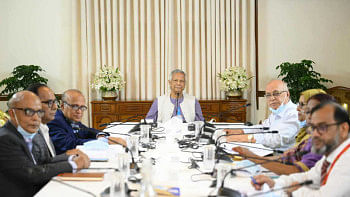Expansionary signal but cautious monetary targets
Overall Bangladesh Bank has maintained policy continuity, albeit may be a bit too much so.
The economy appears to be on a 6 plus percent growth path, inflation is hovering in the same range, the exchange rate is stable at around Tk 78.5/USD, reserve build-up may have moderated but still continuing, short-term interest rates have declined by 4.5 percentage points (on 91-day T-bills) in the 12 months ending December 2015, call money rate is at a historic low (well below 4 percent), and rate on bank advances has declined by 1.1 percentage points in the 12 months ending October 2015.
Private sector credit growth through November has been below the July 2015 monetary policy statement (MPS) target of 15 percent and credit to the public sector has been in the negative growth territory in the first five months of FY2016. Private investment demand may have picked up somewhat but the evidence on the pick-up is mixed and unconvincing. Major constraints on investment continue to be on the supply side -- transport infrastructure deficit, high cost of doing business, lack of access to medium and long-term finance (even at current interest rates), and lingering political uncertainties.
The risk to the global outlook appears to be still on the downside, but the terms of trade gains experienced recently due to decline in fuel and food prices are likely to be sustained.
In this context, there is hardly any reason to make any major mid-term corrections into the overall monetary policy stance announced in the July 2015 MPS. Nominal GDP growth is unlikely to exceed 13.3 percent in FY2016. Thus, the revised 14.3 percent reserve money and 15 percent broad money growth targets are more than adequate to accommodate the projected 6.8 percent real GDP growth and 6.07 percent inflation target.
Year-on-year non-food inflation surpassed 7 percent in December for the first time since July 2013. Containment of inflation has largely been due to declining food prices, thanks to good domestic harvests and declining international prices. This is a signal good enough not to risk excessive divergence between nominal GDP growth and the growth of broad money. The revised broad money growth target reduces this divergence. Perhaps BB could have been a bit more ambitious in lowering the inflation target below 6 percent.
But then without favourable developments on the supply side such a decrease in domestic petroleum prices, an inflation target well below the previous year's level is incongruent with a GDP growth target well above both the previous year and also the economy's potential growth rate.
The composition of the monetary programme needed correction to bring them in line with the outcomes on net foreign assets and credit to the public sector. With net sale of national savings certificates reaching 44.5 percent of the FY2016 budget target in the first quarter of FY2016, it is likely that the government's bank borrowing target for FY2016 may be undershot. In order to accommodate the warranted increase in the monetary programme's NFA (net foreign asset) growth target to bring it in line with what can be realistically expected without increasing the reserve or broad money growth targets, the public sector credit growth has been revised downwards. This may also have necessitated a minor reduction in the private sector credit growth target from 15 percent to 14.8 percent. It is most likely to be undershot any way if the weaknesses in investment demand continue in the rest of the current fiscal year.
The revised stance on policy rates provides a signal to bankers to expand private credit by reducing lending rates. Demand for repo has been weak, understandably so because of large excess liquidity in the system. Banks apparently are more interested in parking their excess cash in reverse repo. The offered amounts in reverse repo have far exceeded the amount accepted in recent auctions. Given that the overall balance of payments is projected to have a large surplus, reserve accumulation may have to continue for a while to prevent further erosion in the competitiveness of the real effective exchange rate. This would require continued sterilisation.
To avoid the adverse impact on the profits of the BB, this was an opportune time to reduce the reverse repo rate and correspondingly the repo rate. These reductions signal to the banks to be more proactive in finding bankable projects to lend in the private sector. There is not much more to this than just the signalling aspect. Even if the banks do not pass the lower interest rates onto customers, they will be able to borrow more which they can pump into the system.
There is also a risk which BB must guard against. Risks to the financial system increase, the lower the rate goes. With repo money getting cheaper, banks with funding shortfall will be tempted to avail the liquidity support more. Funding shortfall can result from careless lending too. BB will need to be careful in accepting repo bids from badly managed banks. The MPS does recognise that the recent rise in non-performing loans is “alarming” while assuring that BB “will not be lenient in this regard”.
It is important to appreciate how the policy repo rate works. It is not a window for banks to borrow clean funds from the BB, to lend to their customers. It is a window through which excess government securities held by banks, beyond statutory requirements, can be funded by the BB. It frees up banks' deposits to be deployed towards lending. At a systemic level, therefore, loans given out by banks and statutory assets held by them, are funded by the bank's own capital and customer deposits, not by borrowing funds from the BB through the repo window.
For lending rates to decline, therefore, bank deposit rates and/or cost of capital need to decline. Repo rate cuts do not inject fresh liquidity into the system. Banks are still left to compete for their share of the same stock of total bank deposits. In a developing economy like Bangladesh, policy rate moves have a comparatively immediate impact on bank treasuries and debt markets, and are transmitted somewhat sluggishly to bank deposit rates, and even more sluggishly to bank lending rates.
The writer is lead economist at the World Bank's Dhaka office.

 For all latest news, follow The Daily Star's Google News channel.
For all latest news, follow The Daily Star's Google News channel. 



Comments